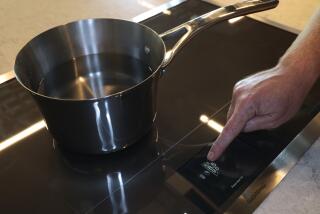Think ‘new models’ to save energy
- Share via
When you buy an appliance, you get an instruction booklet that tells you how to operate it. But what you need is a guide for choosing the right appliance in the first place.
Take a walk around your home and note how many products you have plugged into electrical outlets. The average homeowner is spending about one-fifth of the monthly power bill on the energy that is being used for home appliances -- with the bulk of that amount going toward the major energy-users: refrigerator, stove, dishwasher, clothes washer and dryer.
So to make your life easier when you need to purchase one of these big-ticket items, here are tips that will help you pick a product that not only will do its job but also will do it efficiently and cost-effectively:
* If you’re using a major home appliance that is 10 to 15 or more years old, think about replacing it. Just because it still works is no reason to keep it. Product improvements in recent years have made today’s appliances enormously more efficient than those of just a decade or more ago, and the costs of operating an older appliance can be substantial.
* Consider one of the front-loading horizontal axis clothes washers that uses a third of the water to wash the same amount of clothes as your current one does. They spin faster too, resulting in reduced drying time and costs. And because 90% of the energy used to operate a washing machine is for heating the water, an efficient model can make a huge difference.
* If your new stove has ceramic, halogen or induction range elements, it will be more efficient than one with the old-style electric coil. It’ll be easier to clean too, and will allow more control of cooking temperature.
* Read the yellow EnergyGuide labels when shopping for a major appliance. Federal law requires them, and they’ll inform you not only of the expected energy use of the product but also how the product compares with the most-efficient and the least-efficient products available.
You can get an accurate estimate of what your energy costs will be by plugging in your area’s kilowatt hour rate, because the number shown is based on a national average.
* Buy Energy Star appliances. This government program allows manufacturers whose appliances exceed federal minimum efficiency standards by 15% to 20% or a specified consumption level to use the Energy Star designation. These products are not just energy-efficient; they’re the most energy-efficient possible.
* Don’t be so impressed by features of appliances that you buy more than you need. Ever buy a car because it had a fancy radio or you liked the leather steering wheel a lot? The same thing can happen with a home appliance.
A refrigerator that is much larger than your household needs will cost more to purchase and more to operate, and it won’t be as efficient if it’s not kept filled.
Do you think you won’t have much use for an automatic icemaker and a through-the-door dispenser?
Then why buy a refrigerator with them when these features can increase energy use by as much as 20%?
More to Read
Inside the business of entertainment
The Wide Shot brings you news, analysis and insights on everything from streaming wars to production — and what it all means for the future.
You may occasionally receive promotional content from the Los Angeles Times.








